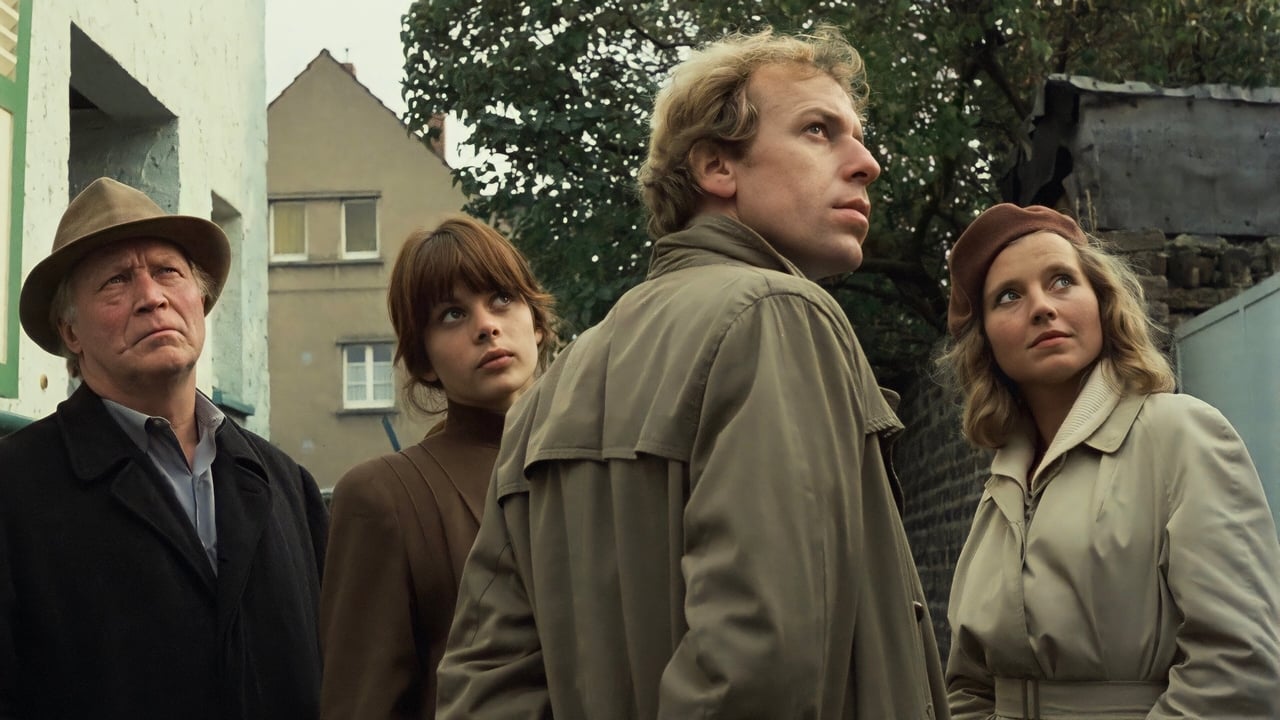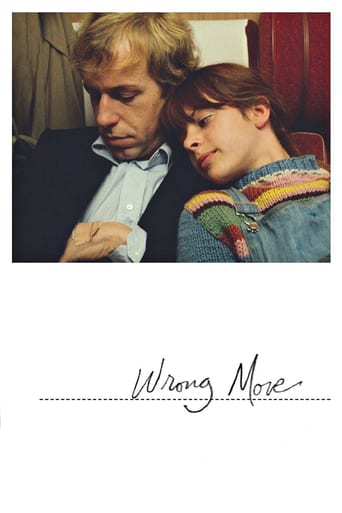

Rudiger Vogler plays a dull, young man who still lives with his mother. He wishes to be a writer, and his mother gives him a push at it when she kicks him out, forcing him to experience the world on his own. This is kind of an abstract narrative. Vogler drifts along picking up new companions, who then accompany him and chat with him on long walks. It's interesting at first, but, frankly, the talk gets pretty boring after a while and it never really goes anywhere. A visual cue in the very first scene should have tipped me off about what I was getting into: William Faulkner's sophomore novel, Mosquitoes, is propped up in an awkward position against a wall so we're sure to see it. Not many people have read that one, and for good reason: it isn't any good. But it follows a very similar structure, as it's about a group of banal people who talk a lot. The story itself is purportedly based on a Goethe novel. Hanna Schygulla and a very young and adorable Natassja Kinski co-star (I kind of suspected Kinski was extremely young, but she was only 14 when the film premiered and she appears topless in the film, which is quite icky).
... View MoreBasically the story of a man who finds that six days of travel doesn't broaden his mind. Made on a tiny budget, on a very tight four-week shoot, TWM punches well above its weight. Full of incident and drama, but none of it is related to anything but the general theme of "life is sh*t and then you die" - which you soon get used to; and some of it's actually very funny. A group of six people drift together, then drift apart. All of them are disenfranchised from politics, society and love, and the dialogue is typically Pinteresque: long pauses, non-sequiturs and deep feelings not being expressed, just like real-life dialogue.Thought-provoking and haunting, beautifully filmed and acted,, TWM is a great "mood movie". You may find it frustrating if you're looking for resolution or even logic, but the observations about life and people in general are as true as you'll get. Woody Allen, eat your heart out.
... View MoreWenders' road movies of the 70s have a charm that makes them accessible to many viewers, yet are often linked by the less accessible themes of alienation and detachment. It is an interesting dichotomy and one that comes to focus with this film. Political and cultural pre-determinism are not as easily digested outside the German point of view in the 70s, yet it is a common theme amongst Wenders films as well as (arguably) Herzog & Fassbinder (New German cinema contemporaries) . One does not have to be a philosophy or poli-sci major to enjoy this film however. The fact that Wrong Move is freely based on Goethe's "Wilhelm Meister's Apprenticeship" is easily overlooked by the casual viewer - but if viewed as an allegorical narrative, like Goethe's work, parts of the film come together and make this obtuse, personal work by Wenders more interesting.The characters Wilhelm (Rudiger Volger) meets during his trip represent ideological sensibilities of 70s Germany. Mignon played by the teen Nastassja Kinski represents the youth and future of Germany (mute, trusting yet undemanding). Laertes represents the idealism of old Germany, and considers himself a martyr for the Nazi cause. Wilhelm and Therese (Hanna Schygulla) are between these 2 and take action to liberate one from the other. All is told in an un-naturalistic style that only works in some cases. The long (almost single take) walk up the hillside by the river are a good example of where the film shines. The photography by Robby Müller is consistently excellent here.It's a difficult film but rewarding to those who take time to understand it from it's original historical and ideological context. Worth seeing for the cinematography of Müller and the presence of Hanna Schygulla and Nastassja Kinski.
... View More"The Wrong Move" is essentially a plot less film about loneliness that follows a late twenty-ish year old, blond German writer-to-be for six days. He is someone who is in search of something. The film is in German with English subtitles and is unusual in that there are occasional first person voice over/commentaries by the principal character by which we know exactly what he is thinking. The film is set in the early 70's with a short audio track of American rock that dates the movie. Through his first person commentary, the writer freely admits that he is not very good at observing people nor does he like people, which leads one to wonder what kind of writer is he? Because "The Wrong Move" is a Wim Wender's film, one inevitably notices the carefully composed shots with meticulous attention to detail. This brief odyssey is a more sophisticated version of candid camera in which the confused writer encounters a handful of people. The film, then, is about his interactions with these people. These characters appear randomly, interact, and disperse. This is probably Nastassja Kinski's first film. If not, then the likelihood of ever watching whatever preceded "The Wrong Move" is close to zero. Long out of print, "The Wrong Move" was only available on scarce, hard to find VHS tape that can be exorbitant in cost, but now is one of eight DVD's in the Wim Wenders Collection Vol 2. It is extremely unfortunate that the DVD has been enhanced for pseudo wide screen, meaning that the original 4:3 image has been chopped, losing some of the image of the original VHS tape. The film was low budget and has attained near cult following among some. Nastassja was a whole thirteen years old when "The Wrong Move" was filmed. This was the first of three films that she has made with Wim Wenders with the other two being: the legendary 1984 "Paris, Texas" and the powerful 1993 "Faraway, So Close." In "The Wrong Move," Nastassja is cast as a mute - meaning that she doesn't speak, has no lines of dialog, and doesn't use anything resembling sign language. Her on screen presence is then all facial expression and body language. In some scenes she looks like a scruffy, scrawny twenty year old.Other times, she has the face of a twelve year old. Sometimes she is a well made up teenager. Sometimes not. But there are always the tennis shoes and the way that she walks that underscores that she is a very young adolescent girl. In the hands of Wim Wenders, her performance is fluid and natural. She and her much older male companion/guardian make their living with Nastassja as a street performer - one that is not highly skilled and in some respects awkward. That has to do more with her young age, rather than a lack of physical skills. Nastassja is a juggler and not a very good one as she usually drops one of the balls. One time she stands on her head, another time she does cart wheels. Eight years later in "Exposed" this gymnastic talent would be on full display in a very sexy, solo performance in front of an all seeing mirror. There is one particular memorable scene in which the writer and the band of strangers are walking through a neighborhood street, observing the interchanges between residents on the roof top of the buildings. The timing is exquisite, the look on Nastassja's face is memorable - but that is Wim Wenders and is an indication of the potential first rate talent in this thirteen year old girl. It is no accident that Nastassja is in so many scenes and some of those appearances are very brief. Even in nothing scenes in which she is not doing anything out of the ordinary, Nastassja is focused - not sleeping or bored. Peter Sykes, the director of "To the Devil...a Daughter," would later see "The Wrong Move," remember her, and later on in need of a young German actress would hire Nastassja. It is all to easy to see "The Wrong Move" as a very superficial movie. Even the translation of the title presents a problem. Should it be "Wrong Movement?" "False Movement?" "wrong" and "false" imply that there is a "right" move or that one has strayed from the "right" path and is in search of it. Is there a "right" path? Is there a "wrong" path? What is the path? Does it make a difference? These are the types of questions that go to the core of the human experience. There is depth here, but only for those who can "see" into it.
... View More